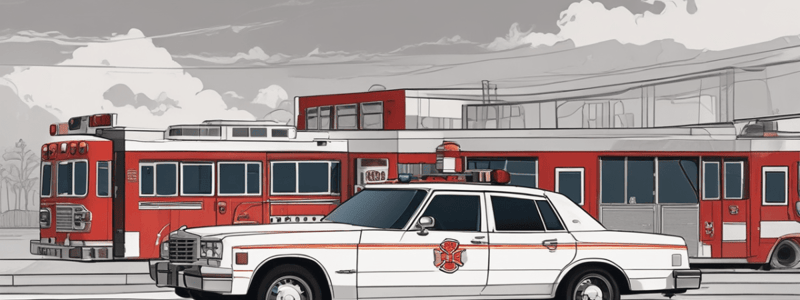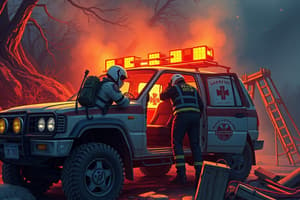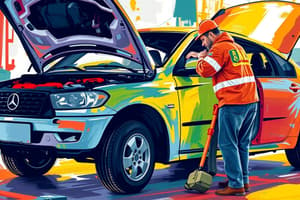Podcast
Questions and Answers
What is the primary purpose of the Vehicle Idling Standard Operating Guidelines?
What is the primary purpose of the Vehicle Idling Standard Operating Guidelines?
- To reduce fuel consumption and lower exhaust emissions (correct)
- To enhance the overall safety of emergency responders
- To improve communication between firefighters
- To increase response times to emergency incidents
How often should fire apparatus leave the station for non-emergency activities?
How often should fire apparatus leave the station for non-emergency activities?
- Only during emergency situations
- A minimum number of times (correct)
- At least once a day
- As needed to fulfill the mission of the Fire Department
What should be done to ensure consistent vehicle voltage for electronic components?
What should be done to ensure consistent vehicle voltage for electronic components?
- Keep the vehicle running at all times
- Attach the vehicle to a 110 volt shoreline (correct)
- Install solar panels on the vehicle
- Use backup generators
How long should a vehicle be started and batteries recharged if it cannot be plugged into a shoreline?
How long should a vehicle be started and batteries recharged if it cannot be plugged into a shoreline?
What should be done with vehicles not actively involved in an incident, but still on the scene?
What should be done with vehicles not actively involved in an incident, but still on the scene?
What should be done with vehicles assigned to the Tollway during an incident?
What should be done with vehicles assigned to the Tollway during an incident?
What should be done with vehicles used to provide emergency lighting during an incident?
What should be done with vehicles used to provide emergency lighting during an incident?
How often should the Vehicle Idling Standard Operating Guidelines be re-evaluated?
How often should the Vehicle Idling Standard Operating Guidelines be re-evaluated?
What is the primary reason ambulances may be idled in below freezing conditions?
What is the primary reason ambulances may be idled in below freezing conditions?
Which of the following statements about idling vehicles in cold weather is correct?
Which of the following statements about idling vehicles in cold weather is correct?
What can be done to prevent unnecessary idling practices when a 110 volt shoreline is available?
What can be done to prevent unnecessary idling practices when a 110 volt shoreline is available?
Which of the following scenarios allows for vehicle idling during non-emergency conditions?
Which of the following scenarios allows for vehicle idling during non-emergency conditions?
What is the maximum time allowed for vehicles to be idled every three hours when not on a 110 volt shoreline?
What is the maximum time allowed for vehicles to be idled every three hours when not on a 110 volt shoreline?
What is the important requirement for engines supplied with a water tank and pump in freezing conditions?
What is the important requirement for engines supplied with a water tank and pump in freezing conditions?
What is the typical battery life of cars if not monitored and left off?
What is the typical battery life of cars if not monitored and left off?
Under what condition should vehicles providing heating or cooling remain idling?
Under what condition should vehicles providing heating or cooling remain idling?
Flashcards are hidden until you start studying
Study Notes
Purpose and Definitions
- The Hoffman Estates Fire Department aims to conserve fuel and reduce exhaust emissions by minimizing unnecessary vehicle idling.
Policy
- Fire apparatus driving should be limited to essential missions only.
- Station Officers should plan daily activities to reduce non-emergency apparatus departures from the station.
- Whenever possible, attach vehicles to a 110-volt shoreline to maintain consistent voltage for electronic components.
Non-Emergency Situations
- If a vehicle cannot be plugged into a shoreline within 3 hours, it should be started and idled for ½ hour to recharge batteries.
Emergency Situations
- Vehicles involved in an incident should remain running as needed during the incident.
- Vehicles not actively involved in an incident but on the scene should be shut off and batteries disconnected.
- Vehicles assigned to the Tollway should remain running throughout the incident.
- Vehicles providing emergency lighting should remain running for as long as needed.
- Vehicles should be shut off during fueling operations.
Special Considerations
- Below freezing conditions:
- Ambulances: Use 110-volt system to maintain temperature in patient compartment or idle the vehicle to maintain temperature and battery charge.
- Engines: Idle and engage pump to prevent water from freezing in pump.
- Cars: Monitor battery life and start the vehicle to recharge when necessary.
Procedure
- Use a 110-volt shoreline to eliminate idling whenever possible.
- When a shoreline is not available, start the vehicle every 3 hours and idle for ½ hour to maintain proper battery charge levels.
Exceptions
- Idling is allowed during emergency incidents to supply electrical power.
- Idling is allowed in below freezing weather to prevent water from freezing in pumps.
- Idling is allowed if an apparatus experiences a charging problem and the operator is unsure if the apparatus can restart.
Studying That Suits You
Use AI to generate personalized quizzes and flashcards to suit your learning preferences.




